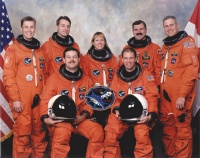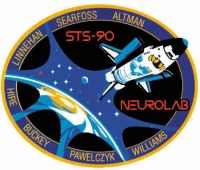STS-90
From The Space Library
 | |
| Organization | NASA-Office of Space Flight (United States) |
|---|---|
| Mission type | Human Crew,Life Science |
| Launch date | April 17, 1998 |
| Launch vehicle | Space Shuttle |
| Launch site | Cape Canaveral, United States |
| COSPAR ID | 1998-022A |
| Inclination | 39 degrees |
| Experiments | Here |
| Alternate Names | 25297 |
| Additional Information | Here |
| Telecommunications Information | Here |
| Data Collection | Here |
| Payload Mass Up | 11861.44 kg |
| Payload Mass Down | 11886.36 kg |
| Orbiter | Columbia |
| Lift Off Mass | 2,056,259.09 kg |
| Orbiter Weight at Liftoff | 119,253.18 kg |
| Orbiter Weight at Landing | 105,051.36 kg |
| Landed | Concrete runway 33 at Kennedy Space Center, Fla. |
| Orbits of Earth | 256 |
| Orbital Altitude | 150 nautical miles (173 statute miles) |
Contents |
Crew
- Commander: Richard A. Searfoss
- Pilot: Scott D. Altman
- Payload Commander:
- Mission Specialist 1: Kathryn "Kay" Hire
- Mission Specialist 2: Richard M. Linnehan
- Mission Specialist 3: Dafydd (Dave) Rhys Williams, Canadian Space Agency
- Mission Specialist 4:
- Mission Specialist 5:
- Payload Specialist 1: Dr. Jay C. Buckey
- Payload Specialist 2: Dr. James A. Pawelczyk
ISS/Mir Crew Transport
Mission
The primary mission of STS 90 was to conduct a comprehensive list of neurobiological experiments and observations on a number of species: seven humans, 18 pregnant mice, 152 rats (including 12 females with prenatal litters of eight each, and two with litters of seven each), 229 swordtail fish, 60 snails, 75 snail pawn packs, 824 crickets, and 680 cricket eggs. According to a principal investigator (of rat research), "the findings from the microgravity experiments may help gain some more insight into the best way to treat neurologic patients with Parkinson's disease, and balance disorders." According to the project scientist of the mission, "it is important to note that the sensory and motor development events and processes under study in the various species on Neurolab are essentially the same as those that occur in humans, although with a different time frame."
EVA
Payload
Neurolab; Getaway Specials 197, 744 and 772; Shuttle Vibration Forces (SVFs); extended duration orbiter (EDO) cryogenic pallet; Bioreactor Demonstration System (BDS) 04

